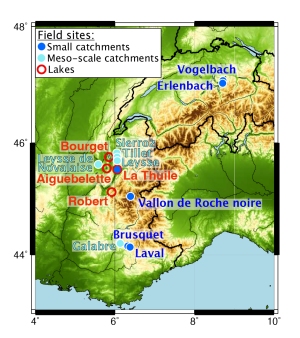Research
The project will focus on the western European Alps, using isotope tracers of chemical weathering (lithium and strontium isotopes), combined with a source-to-sink approach, i.e. by tracking dissolved and solid weathering product pathway from the soil, through the river, to the lake deposit and back in time in lake cores.
Work Packages (WP)
LAKE-SWITCH contains three work packages (WP) :
– in WP 1, we will constrain the relationships between the Li-Sr isotopic proxies and chemical weathering in the modern European Alps by studying soil profiles and river catchments.
– in WP 2, we will characterize how the Li-Sr signature of weathering materials is recorded in lake sediments by studying modern Alpine Lake waters and sediments. We seek to determine which authigenic phases (calcite, biogenic silica) are the most suitable for reconstructing paleo-water composition.
– in WP 3, we will measure the Li and Sr isotopic compositions and concentrations in the detrital and authigenic phases in Holocene Alpine Lake cores and use results from WP 1 and 2 to quantitatively reconstruct past chemical erosion over the Holocene under human and climate forcing.
Field sites
We will also study several small Alpine catchments Laval (1.1 km2) and Brusquet (0.9 km2) rivers from the CZO “Draix-Bleone” (observed since 1983), part of the OZCAR network ; Erlenbach (0.7 km2) and Vogelbach (1.6 km2) rivers, from the upper Alptal valley, Vallon de Roche Noire (3.5 km2) from the site Lautaret Roche Noire and the catchments from Lake La Thuile and Lake Robert.
 La fédération
La fédération Intranet
Intranet









